Shifting from WordPress to Shopify marks an exciting step in streamlining your e-commerce processes. As businesses expand, choosing a solution that aligns with scalability, UX, and customization is essential. Shopify has emerged as a preferred choice for online merchants, providing unmatched flexibility, data protection, and ease of use. In this guide, we will delve into why this migration is a game-changer, highlight the benefits, and share actionable steps to facilitate a seamless transition.
1. Top Reasons to Transition from WordPress to Shopify
WordPress, paired with WooCommerce, continues to support countless online stores. Nevertheless, as companies scale, issues like reliance on plugins, data risks, and technical complexities can hinder growth. Shopify, designed explicitly for e-commerce, addresses these issues with an all-in-one, intuitive solution. Real data supports this transition—Shopify hosts over 4.4 million websites globally, with a documented 10% increase in sales conversion rates for numerous merchants post-switch.
2. Key Benefits of Shopify for E-commerce Success
Shopify’s powerful platform is tailored for scaling brands. Its notable features are:
- Seamless Customization: Shopify provides over 80 professionally designed themes.
- Integrated Tools: Capabilities such as Shopify Payments and built-in SEO streamline operations.
- Global Reach: Currency versatility and localization features empower brands to expand internationally.
Additionally, Shopify delivers an uptime rate of 99.98%, guaranteeing your store remains accessible.
3. Getting Ready for Your WP-to-Shopify Transition
Prior to starting the migration process, evaluate your current store. Review product data, customer details, and SEO performance. Resources such as Shopify’s Migration Kit or third-party solutions help ease the transition. Develop a comprehensive plan, making sure all assets—item details, media files, and blog content—are optimized for transfer.
4. Data Migration: A Critical Step
Transferring your data is a cornerstone of a successful platform switch. When moving from WP to Shopify, focus on:
- Product Information: SKU, descriptions, and categories.
- Customer Data: Emails, order history, and custom fields.
- Search Engine Considerations: Retain meta tags, URLs, and forwarding paths to avoid SEO losses.
Use tools such as LitExtension to streamline data transfer while minimizing errors.
5. Customizing Your Shopify Store
Post-migration, customizing your Shopify store helps it reflects your brand. Utilize Shopify’s drag-and-drop editor to design pages effortlessly. Shopify's templates are mobile-responsive, ensuring a seamless user experience across devices—a key point, given 74% of e-commerce traffic comes from mobile users.
6. Maintaining SEO During Migration
Search engine optimization is crucial for maintaining your visibility during migration. Shopify excels in SEO with organized link formatting, built-in optimization tools, and seamless blog integration. Make sure you:
- Implement 301 redirects for existing links.
- Optimize new pages with targeted phrases.
- Leverage plugins like Plug in SEO to monitor performance post-migration.
7. Essential Tests After Migrating to Shopify
After finishing the transfer, run detailed checks.
Check:- Page load times (Shopify delivers faster speeds compared to WP).
- Payment integration reliability and checkout processes.
- Adaptability across devices.
Quality assurance guarantees your store provides a seamless shopping experience from the start.
8. Real-Life Success Story
One such migration success story is Gymshark, a sportswear company that moved to Shopify. After the switch, the company experienced a 60% boost in mobile sales and significantly lowered site downtime. This highlights the capabilities of Shopify in enhancing online business success.
9. Challenges and Solutions
Migration comes with challenges, such as data integrity and adjusting tailored features. However, Shopify’s extensive assistance and third-party experts make overcoming these hurdles manageable. Partnering with experienced Shopify developers ensures a trouble-free transition.
10. Starting Your Journey with Shopify
Migrating from WordPress to Shopify marks a strategic decision to online retail. By addressing scalability, streamlining operations, and enhancing the customer experience, Shopify enables WordPress to Shopify comparison companies to thrive in challenging industries.
Final Thoughts
Transitioning from WP to Shopify offers a smart solution that can greatly enhance your online business performance. With a well-structured strategy, the appropriate resources, and expert support, you can unlock new growth opportunities.
Ready to make the leap? Reach out today to learn how our Shopify migration services can transform your online store. Contact us now, or ask yourself: Can your WordPress e-commerce migration business afford to miss out on Shopify’s growth potential?

Comments on “Effortless Transition from WP to Shopify: Your Ultimate Guide to E-commerce Success”